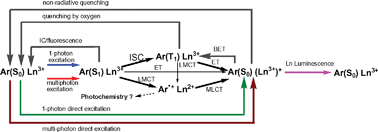Sensitised luminescence in lanthanide containing arrays and d–f hybrids
Abstract
Sensitised luminescence from lanthanide complexes offers many potential advantages in imaging and assay, particularly when coupled with time-gating protocols that can be used to gate out background signal. In this perspective, we discuss the routes by which lanthanide arrays and polymetallic d–f hybrids can be prepared by conventional synthesis and

- This article is part of the themed collection: Supramolecular photochemistry

 Please wait while we load your content...
Please wait while we load your content...